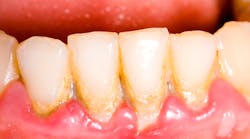How often do patients question us regarding the relevance of their health history and medication list when they’re “just getting a cleaning?” Most of us have likely memorized a short speech on the importance of a thorough medical history, and we’re committed to educating patients on this topic.
But how often does nutrition come up in these discussions? Do we question caries-prone patients about their diets? What about patients with acid reflux, cardiac conditions, or diabetes? It’s important to interview patients regarding their diets to determine whether how they eat and drink could be affecting more than their overall health.
The impact of processed foods
The popularity of processed foods began in the 1920s as more women entered the workforce. Convenience products such as Wonder Bread, Peter Pan peanut butter, and Kraft macaroni and cheese became popular. By the 1940s, boxed cake mixes and instant coffee were commonplace.1 Researchers have found that over a span of 18 years, the daily percentage of calories from ultra-processed foods rose from 53.5% to 57%, with a significant decline in whole food consumption.2
Despite widespread advice to "eat your vegetables" and "snack smart," the prevalence of overweight and obese people in the US is alarming. The CDC reports that about 75% of US adults ages 20 and older are overweight or obese, compared to 56% three decades earlier. This has serious implications for overall and oral health.3
Obesity and oral health
Obesity is linked to conditions such as cardiovascular disease and diabetes, which in turn affect oral health. Chronic inflammation from obesity impacts the entire body, including the oral cavity. Poor oral hygiene can contribute to heart disease, and vice versa.4 The International Journal of Cardiology notes that people who brush their teeth less than twice daily have a 50%–60% higher risk of cardiovascular events and a 70% higher risk of dying from such events.5 Simple daily oral hygiene routines can significantly impact overall health.
A study from April 2024 found a strong correlation between the periodontal pathogen Selenomonas noxia and obesity. S. noxia, found in 86% of overweight to obese patient samples, digests nondigestible fibers, increasing caloric extraction from food.6
Obesity significantly increases the risk of developing type II diabetes mellitus (T2DM). As oral health-care providers, we’re know that obesity-related inflammation leads to insulin resistance, creating a vicious cycle causing increased glucose circulation, which exacerbates oral conditions like caries and periodontal disease.7 A study from India shows that 73.3% of diabetic patients had carious lesions compared to 33.3% of nondiabetic patients, further highlighting the interconnection between diabetes and oral health.8
Fad diets and their effects on health
Intermittent fasting (IF): Intermittent fasting (IF) has become popular for weight loss and improved glucose control, leading to higher insulin sensitivity. Historical figures such as Hippocrates and Plato recommended fasting for health benefits, and it remains integral to many religious practices. The past two decades have seen increased research and popularity around IF.9
IF involves cycling between fasting and periods of eating. Common methods include the 16/8 method (fasting for 16 hours and eating during an eight-hour window) and the 5/2 approach (eating normally for five days and consuming 500-600 calories on two days).10,11 While IF can improve glucose response and reduce inflammation, it also decreases salivary flow, which increases the risk of caries, xerostomia, and halitosis.12,13 Patients who are caries prone or suffer from medication-induced xerostomia should consult their health-care providers before starting IF.
Ketogenic (keto) diet: Dr. Russell M. Wilder coined the term “ketogenic diet” in 1921 to treat epilepsy.14 The diet became popular again in the 1970s for its weight loss and diabetes management potential. The ketogenic diet induces ketosis, where the body uses fat for energy instead of carbohydrates, leading to lower glycated hemoglobin (HbA1c) levels and weight reduction in diabetics. The diet also lowers triglycerides and increases HDL cholesterol (the “good” cholesterol), though it may raise LDL cholesterol (the “bad” cholesterol).15
The ketogenic diet focuses on low carbohydrate, moderate protein, and high-fat intake. A typical keto breakfast might include eggs, bacon, and avocado, while lunch could be a grilled chicken salad with mixed greens and an olive oil-based dressing. This diet avoids minimal grain-based foods like bread, cereals, and pasta due to their high carbohydrate load.
While the ketogenic diet offers weight loss and improved glucose control benefits, it also impacts oral health. The reduced carb intake can decrease caries risk, as there is less sugar to feed harmful oral bacteria.16 However, the high-fat content may lead to halitosis, or “keto breath,” due to the production of ketones during ketosis. This can smell like acetone, chemicals, or have a sweet, fruity odor. Some report a metallic taste. Ensuring hydration and reducing protein intake can help mitigate keto breath.17 A lack of dietary variety can also result in deficiencies in vitamins and minerals that are crucial for oral health, such as vitamin C, which is essential for gum health.14
Veganism: Forms of vegetarianism and veganism have been practiced for thousands of years. Unlike a vegetarian diet, veganism removes all animal products, including eggs, honey, and dairy. Many people follow veganism for ethical reasons or health benefits.15 Vegans benefit from an increased intake in dietary fiber, vitamins C and E, and minerals such as magnesium.
However, veganism carries a high potential for vitamin deficiencies. Animal products contain beneficial vitamins and minerals such as vitamin B12, iron, and omega-3 fatty acids, which are not readily available through a plant-based diet. Vitamin B12 is essential for a healthy periodontium; a deficiency can result in glossitis and intraoral ulcers.
Animal proteins are considered “complete” because they include all essential amino acids in the proper proportions. Plant-based proteins do not provide all these amino acids, making it imperative for vegans to plan well to include all amino acids in their diet. Studies suggest that vegans are prone to dental erosion due to high ingestion of acidic fruits and vegetables.18
A lack of dairy intake increases the potential for calcium and vitamin D deficiencies. Uninformed vegans also have a strong possibility for deficits in many other vitamins and minerals.19 If a patient is interested in beginning a vegan diet or is currently a practicing vegan, stress that they consult a doctor or nutritionist prior to starting a vegan diet.20
Understanding the link between diet, weight loss, and oral health helps you provide comprehensive patient care. Educating patients about the impact their diets have on general and oral health can lead to better health outcomes.21 Whether considering diets like intermittent fasting, a ketogenic diet, or veganism, evaluate their potential benefits and risks, particularly concerning oral health. By doing so, we can help patients make informed decisions that support their overall well-being.
This article was written with the assistance of artificial intelligence for the sole purpose of condensing its length.
References
1. Processed Foods History: 1910s to 1950s. Modern Pioneer Mom. July 5, 2012. Accessed July 7, 2024. https://modernpioneermom.com/2012/07/05/processed-foods-history-1910s-to-1950s
2. Harrison R. Americans Are Eating More Ultra-Processed Foods. NYU. October 14, 2021. https://www.nyu.edu/about/news-publications/news/2021/october/ultra-processed-foods.html
3. DeSilver D. As obesity rates rise in the U.S. and worldwide, new weight-loss drugs surge in popularity. Pew Research Center. https://www.pewresearch.org/short-reads/2024/03/21/as-obesity-rates-rise-in-the-us-and-worldwide-new-weight-loss-drugs-surge-in-popularity
4. Bulló M, Casas-Agustench P, Amigó-Correig P, Aranceta J, Salas-Salvadó J. Inflammation, obesity and comorbidities: the role of diet. Public Health Nutrition. 2007;10(10A):1164-1172. doi:https://doi.org/10.1017/s1368980007000663
5. Aleksandric S. Poor oral health: Cause or risk factor for future cardiovascular diseases. February 9, 2022. Accessed July 7, 2024. International Journal of Cardiology. https://www.internationaljournalofcardiology.com/article/S0167-5273(22)00219-4/abstract
6. Williams A, Porter J, Kingsley K, Howard KM. Higher Prevalence of the Periodontal Pathogen Selenomonas noxia among Pediatric and Adult Patients May Be Associated with Overweight and Obesity. Pathogens. 2024;13(4):338. doi:https://doi.org/10.3390/pathogens13040338
7. Wondmkun YT. Obesity, insulin resistance, and type 2 diabetes: Associations and therapeutic implications. Diabetes, Metabolic Syndrome and Obesity: Targets and Therapy. 2020;13(13):3611-3616. https://www.ncbi.nlm.nih.gov/pmc/articles/PMC7553667/
8. Malvania EA, Malvania EA, Sheth SA, et al. Dental caries prevalence among type II diabetic and nondiabetic adults attending a hospital. Journal of International Society of Preventive and Community Dentistry. 2016;6(9):232. doi:https://doi.org/10.4103/2231-0762.197202
9. Intermittent fasting: Historic and scientific aspects. Kinnu. August 24, 2022. https://kinnu.xyz/kinnuverse/lifestyle/intermittent-fasting/historic-and-scientifc-aspects/
10. Johns Hopkins Medicine. Intermittent fasting: What is it, and how does it work? Johns Hopkins Medicine. 2021. https://www.hopkinsmedicine.org/health/wellness-and-prevention/intermittent-fasting-what-is-it-and-how-does-it-work
11. Not Sure Where To Start With Intermittent Fasting? The 16:8 Schedule Is A Great Entry Point. Women’s Health. February 12, 2024. Accessed July 7, 2024. https://www.womenshealthmag.com/weight-loss/a29349587/intermittent-fasting-schedule/
12. Besbes A, Khemiss M, Bragazzi N, Saad HB. The Impacts of Ramadan Intermittent Fasting on Saliva Flow-Rate and Metabolic Data: A Systematic Review. Frontiers In. April 5, 2022. Accessed July 7, 2024. https://www.frontiersin.org/journals/nutrition/articles/10.3389/fnut.2022.873502/full
13. Patterson RE, Sears DD. Metabolic Effects of Intermittent Fasting. Annual Reviews. July 17, 2017. Accessed July 7, 2024. https://www.annualreviews.org/content/journals/10.1146/annurev-nutr-071816-064634
14. Russell M. Wilder. New York Public Radio Podcasts. WNYC. https://www.wnyc.org/people/russell-wilder/
15. Masood W, Uppaluri KR, Annamaraju P. Ketogenic diet. National Library of Medicine. March 21, 2019. https://www.ncbi.nlm.nih.gov/books/NBK499830/
16. Kalpe S, Mathur A, Kharat P. How fad diets may jeopardize your oral well-being: The hidden consequences. Human Nutrition & Metabolism. 2023;33:200214. doi:https://doi.org/10.1016/j.hnm.2023.200214
17. What Is Keto Breath, and How Can You Get Rid of It? Healthline. April 13, 2018. https://www.healthline.com/health/keto-breath
18. Smits KPJ, Listl S, Jevdjevic M. Vegetarian diet and its possible influence on dental health: A systematic literature review. Community Dentistry and Oral Epidemiology. 2020;48(1):7-13. doi:https://doi.org/10.1111/cdoe.12498
19. Craig WJ. Health effects of vegan diets. The American Journal of Clinical Nutrition. 2009;89(5):1627S1633S. doi:https://doi.org/10.3945/ajcn.2009.26736n
20. Akl S, Ranatunga M, Long S, Jennings E, Nimmo A. A systematic review investigating patient knowledge and awareness on the association between oral health and their systemic condition. BMC Public Health. 2021;21(1). doi:https://doi.org/10.1186/s12889-021-12016-9
21. Donley T, Sealove B. Beyond pocket depth: Bacteria, periodontitis, and total body health. Dental Economics. May 22, 2024. Accessed July 7, 2024. https://www.dentaleconomics.com/science-tech/article/55016694/beyond-pocket-depth-bacteria-periodontitis-and-total-body-health
About the Author
Melissa Alt, RDH
Melissa Alt, RDH, has been a practicing dental hygienist for more than six years. Prior to dental hygiene school, she worked as a dental assistant in both general and specialized fields of dentistry, all while enjoying this fascinating field of study. Melissa has an interest in researching common issues such as dental anxiety, oral and general health care fads, and nutrition, and how these can relate to our careers as dental hygienists.


